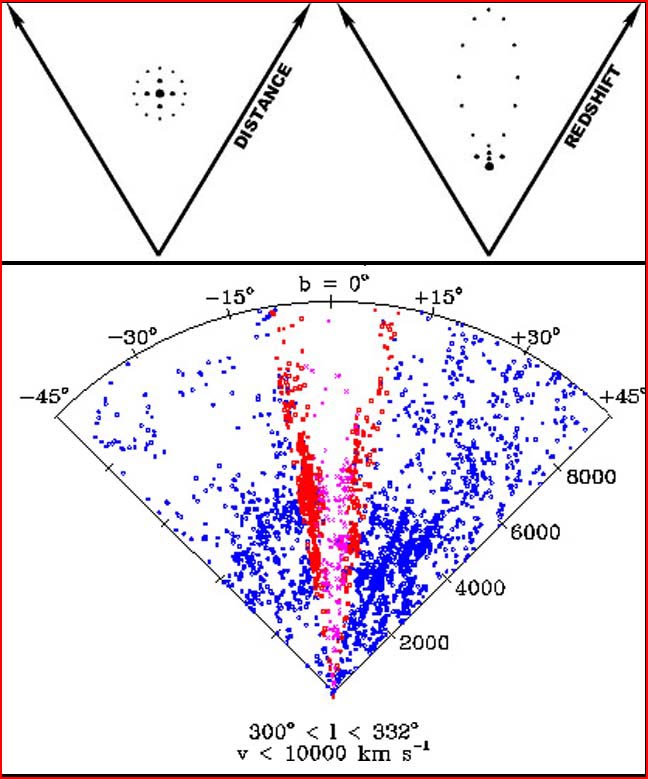|
The big bang
theory predetermines the size, the shape and the age of
the universe (according to the latest satellite data, it
is an expanding sphere 78 billion light years in
diameter and 13.7 billion years old.) Because
astronomers believe that redshift is a measure of
distance, most of the distances of millions of galaxies,
quasars, and gamma ray bursts have been distorted. A
different interpretation of redshift will imply a much
different universe. Halton Arp's research shows that
redshift cannot be a measure of distance. The charts
above compare a galaxy cluster in Arp's observed
universe to the big bang's theoretical universe.
These three
diagrams are called "pie charts" because of their
resemblance to slices of pie. Our position (the Earth)
is at the bottom point in all cases. Distance (away from
the Earth) is measured along the straight edges. In the
top left image, we show what a galaxy cluster in Arp's
universe would look like without the big bang
perspective. It is a family of galaxies and quasars and
gaseous clouds of mixed redshifts (in the top diagrams,
the large dots are low- redshift, the medium-sized dots
are medium-redshift, and the small dots are high
redshift). At the center, there is a dominant galaxy --
it's usually the largest galaxy, and the galaxy with the
lowest redshift of the cluster. This galaxy is
surrounded by low-to-medium redshift galaxies, and
toward the edges of the cluster we find the highest
redshift galaxies, HII regions, BL Lac objects and
quasars.
The image to the
right shows what happens if we try to force the same
galaxy cluster into a redshift-equals-distance
relationship. The cluster becomes distorted. What was
once a sphere becomes an elongated bubble. The central
dominant galaxy drops to the front of this bubble,
followed by a spike of low-to-medium redshift galaxies
stretching away from the earth and "bubble and void" of
high redshift objects.
Every cluster in
the sky does this, like fingers of god pointed at the
earth from every direction. The third image is a 90
degree slice of the sky showing all galaxies arranged
according to their redshift- determined distances. The
Fingers of God distortions show clearly, each
representing a single galaxy cluster. (The bubbles and
voids are not as clear, because this chart cuts off
before it gets to high redshift.) Everything points at
the Earth.
Without the
redshift-equals-distance distortion, a new picture of
galaxy clusters and the universe itself is revealed. The
age of the universe is no longer known, because we no
longer have a constant expansion to backtrack to a bang.
The size is also unknown. Most quasars and some galaxies
that we see are closer than we thought they were,
because they have been distorted by the Fingers of God.
But we have no idea how far the universe stretches
beyond our telescopes' limits. We have moved from what
has been called "the end of science", where everything
has basically been discovered, to "the beginning of a
new universe" where almost everything is unexplored
territory. What an exciting prospect for science in the
21st century.
Quasar in Front of a Galaxy
The Search for Two Numbers
[See Arp's lecture video, "Intrinsic
Redshift," for more details of this new picture of
the universe.] Available from Mikamar Publishing |

